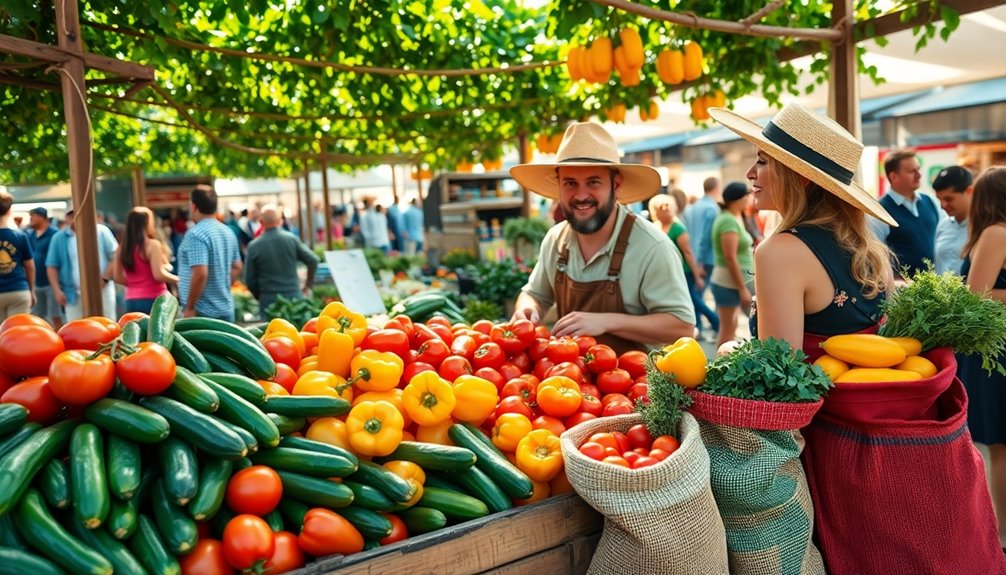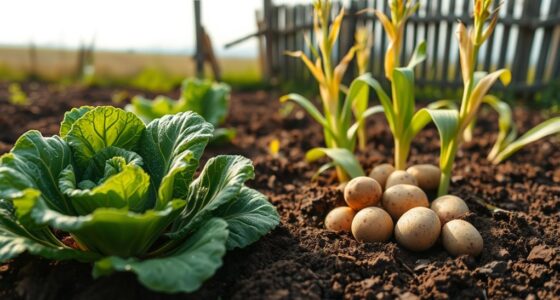To plan a fall brassica rotation, start by selecting resistant varieties suited for your climate and maturity timing to avoid frost damage. Prepare your soil with testing and organic amendments like compost or lime to optimize growth. Practice crop rotation to break pest and disease cycles, and consider incorporating cover crops for soil health. Using physical barriers and timely harvests help prevent issues. If you keep exploring, you’ll discover more tips for a successful fall crop cycle.
Key Takeaways
- Select cold-tolerant brassica varieties with disease resistance suitable for your local climate and expected first frost date.
- Plan crop rotation to avoid planting brassicas on the same site annually, reducing pest and disease buildup.
- Prepare well-drained, nutrient-rich soil by testing, amending pH, and incorporating compost or cover crops for optimal growth.
- Schedule planting based on soil temperatures and day length, aiming for an early fall window to maximize harvest before frost.
- Use integrated pest management strategies, including crop diversification, physical barriers, and timely removal of infected plant material.
Timing and Scheduling for Fall Brassica Planting

Timing is crucial when planning a fall brassica crop, as planting too early or too late can affect growth and yield. You need to identify the ideal planting window to ensure your brassicas develop properly before colder weather sets in. Plant too early, and you risk bolting or disease; plant too late, and the plants may not mature in time for harvest. By aligning your planting schedule with local climate conditions, you can better synchronize growth with your desired harvest schedule. Monitoring soil temperatures and day length helps pinpoint the best time to sow. Staying within this window maximizes your chances of a healthy crop and an efficient harvest, ensuring your brassicas reach maturity when you want them to. Additionally, understanding planting timing can help optimize vegetable growth and maximize nutrient retention. Recognizing relationships between planting dates and environmental factors can further improve your success rate, especially when considering seasonal variations in weather patterns. Being aware of crop-specific requirements also plays a significant role in adjusting your schedule for optimal growth conditions, and incorporating adaptive planting strategies can help mitigate unexpected weather fluctuations.
Selecting the Right Brassica Varieties for Autumn
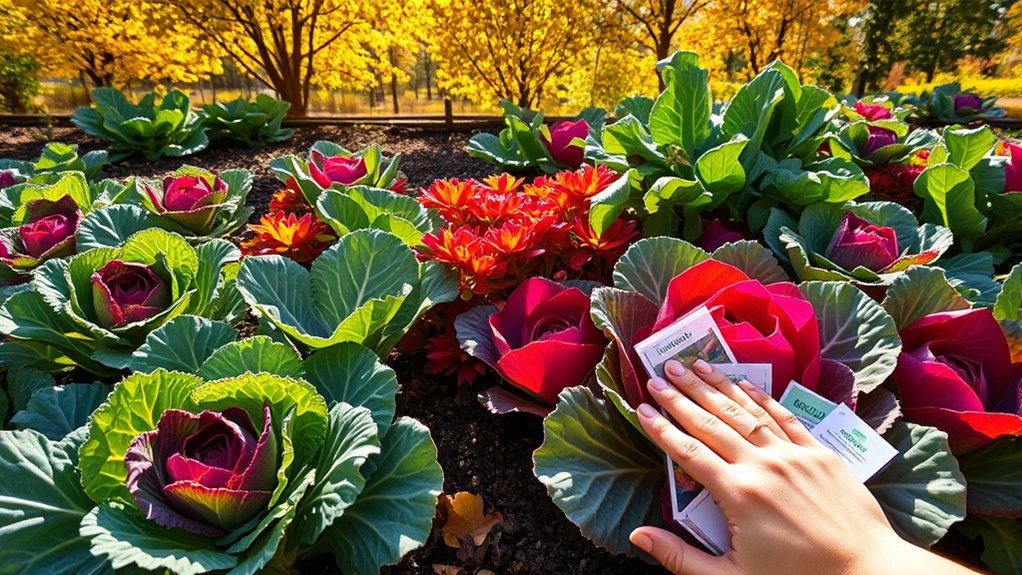
Choosing the right brassica varieties for fall depends on their cold tolerance and how quickly they mature. You should also consider disease resistance traits to protect your crops throughout the season. By selecting varieties aligned with these factors, you’ll set yourself up for a successful autumn harvest. Incorporating disease-resistant traits can also help identify wild plants that may support your crop diversity and resilience during the fall season. Additionally, understanding plant hardiness zones can guide you in selecting varieties best suited for your local climate conditions.
Variety Cold Tolerance
Selecting brassica varieties that can withstand cold temperatures is essential for a successful fall crop. Cold tolerance and frost resistance guarantee your plants survive early frosts and chilly nights. When choosing varieties, look for those bred specifically for autumn planting. Some cultivars have inherent frost resistance, allowing them to thrive even in freezing conditions. Additionally, understanding the bedroom environment can help optimize plant placement and protection strategies. Keep in mind, frost-resistant varieties give you flexibility in planting dates and reduce crop loss risks. Incorporating hardiness traits into your selection process can further improve your chances of a successful harvest. Considering plant adaptability can also help select varieties that perform well under varying fall weather conditions. Understanding the genetic makeup of different brassica cultivars can also assist in selecting the most resilient options for colder climates. Moreover, selecting varieties with hybrid vigor can enhance overall cold tolerance and productivity.
Maturity Timing Selection
To guarantee your brassicas mature before the first hard frost, it’s essential to select varieties with appropriate growth durations for autumn planting. Maturity timing is critical for aligning harvest scheduling with seasonal weather patterns. Choose quick-maturing varieties if your growing season is short or if a late-season frost is expected. Conversely, if you have a longer fall window, consider varieties with extended maturity periods to maximize yield and size. Check seed packet information for estimated days to maturity and compare these to your local first frost date. Proper maturity timing ensures you harvest healthy, flavorful brassicas at peak quality, avoiding damage from early frosts. Planning your variety selection based on these factors will help you achieve a successful fall brassica crop.
Disease Resistance Traits
Have you considered how disease resistance traits can impact the success of your fall brassica crop? Selecting cultivars with strong disease resistance traits enhances your crop’s durability against common threats like black rot, downy mildew, and clubroot. By choosing varieties with proven disease resistance, you reduce the need for chemical controls and minimize yield losses. Cultivar durability varies; some cultivars naturally resist multiple diseases, making them more reliable over successive seasons. Evaluate your local conditions and select varieties specifically bred for disease resistance in your region. This strategic choice not only improves crop health but also ensures a more consistent and profitable harvest. Understanding how disease resistance traits influence crop success can help you make more informed seed selection decisions. Incorporating resistance durability into your selection process ensures you choose the most resilient options for your fall brassica rotation. Additionally, considering plant genetics can further enhance your ability to select durable, disease-resistant cultivars that thrive in your specific growing conditions. Selecting for potential for resistance can also help future-proof your crop against emerging threats. Recognizing the importance of environmental adaptability can aid in selecting varieties that perform well under varying fall conditions. Prioritizing disease resistance traits in your selection process is a key step toward a resilient and successful fall brassica rotation.
Preparing Your Soil for Brassica Crops
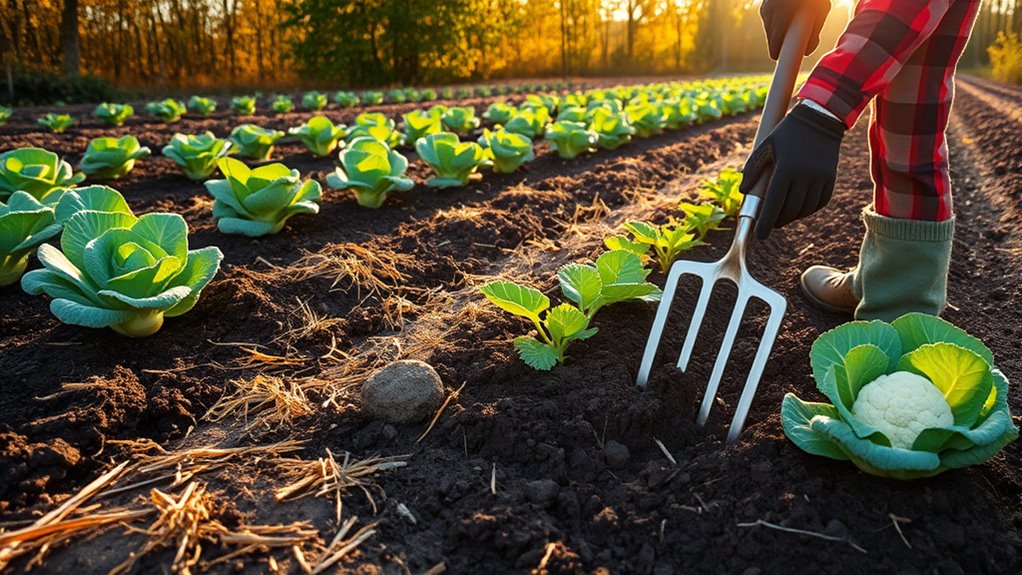
Before planting brassica crops, you need to make sure your soil is well-prepared to promote healthy growth. Start with soil testing to determine nutrient levels and pH balance. This step helps you identify deficiencies or imbalances that could hinder crop development. Based on the results, apply the appropriate fertilizer to guarantee your soil has the right nutrients, especially nitrogen, phosphorus, and potassium. Incorporate organic matter like compost to improve soil structure and moisture retention. Proper soil preparation creates an ideal environment for brassicas, reduces the risk of disease, and boosts yields. Adding organic matter can also enhance the soil’s fertility and microbial activity, which benefits overall crop health. Additionally, maintaining optimal soil conditions is essential for plant disease prevention, helping to keep your crops healthy throughout their growth cycle. Avoid over-fertilizing, which can lead to excessive vegetative growth or pest problems. Well-prepared soil sets the foundation for a successful fall brassica rotation. Additionally, understanding the importance of asset division can help you plan and manage your resources effectively for future agricultural investments. Maintaining optimal soil conditions is crucial for achieving consistent crop performance in your fall rotation.
Crop Rotation Principles to Prevent Pests and Diseases

Rotating your crops helps break pest cycles and reduces the chances of diseases taking hold. By changing plant families, you disrupt the hosts that pests and pathogens rely on. Additionally, it improves soil health, making your brassicas more resilient and productive.
Break Pest Cycles
How can you effectively break pest cycles in your fall brassica rotation? The key is understanding pest life cycles and disrupting their progression. Pests often survive in the soil or on specific hosts, so planting brassicas repeatedly can lead to infestations. To prevent this, practice crop diversification by rotating brassicas with unrelated crops like legumes or grains. This interrupts pest life cycles, as pests lose their preferred hosts and struggle to reproduce. Additionally, moving brassicas to different fields each season ensures pests don’t establish themselves easily. By diversifying your crops and avoiding continuous planting of brassicas in the same spot, you reduce pest populations naturally. This strategic approach keeps your fall brassica crop healthier and minimizes the need for chemical controls.
Disrupt Disease Hosts
Disrupting disease hosts through crop rotation is essential for maintaining healthy fall brassica crops. By changing plant families and adjusting harvest timing, you prevent pests and pathogens from establishing. Incorporate intercrop strategies, such as planting legumes or herbs alongside brassicas, to reduce disease spread. Timing your harvest carefully ensures residues don’t harbor disease organisms. Use this table to plan rotations effectively:
| Crop Type | Intercrop Strategies | Harvest Timing |
|---|---|---|
| Brassicas | Legumes, herbs | Late summer/fall |
| Non-brassicas | Non-host crops, cover crops | Early fall |
| Disease hosts | Rotate with resistant varieties | Adjusted to crop cycle |
| Residue management | Remove or incorporate residues | Post-harvest |
This approach breaks disease cycles and strengthens your crop’s resilience.
Enhance Soil Health
Enhancing soil health through diverse crop rotations is essential for preventing pests and diseases in fall brassica cultivation. By rotating different crops, you improve soil nutrients, reducing the risk of nutrient depletion that pests often exploit. Incorporating legumes or other non-brassica plants boosts soil nitrogen naturally and supports microbial activity, which is crucial for suppressing pathogens. Healthy microbial activity creates a balanced soil environment, making it harder for pests and diseases to establish. Avoid planting brassicas in the same spot repeatedly, as this fosters pest buildup and weakens soil vitality. Instead, rotate with crops that break pest cycles and enhance soil nutrients. This strategy keeps your soil resilient, promotes vigorous plant growth, and minimizes the need for chemical controls.
Incorporating Cover Crops and Soil Amendments
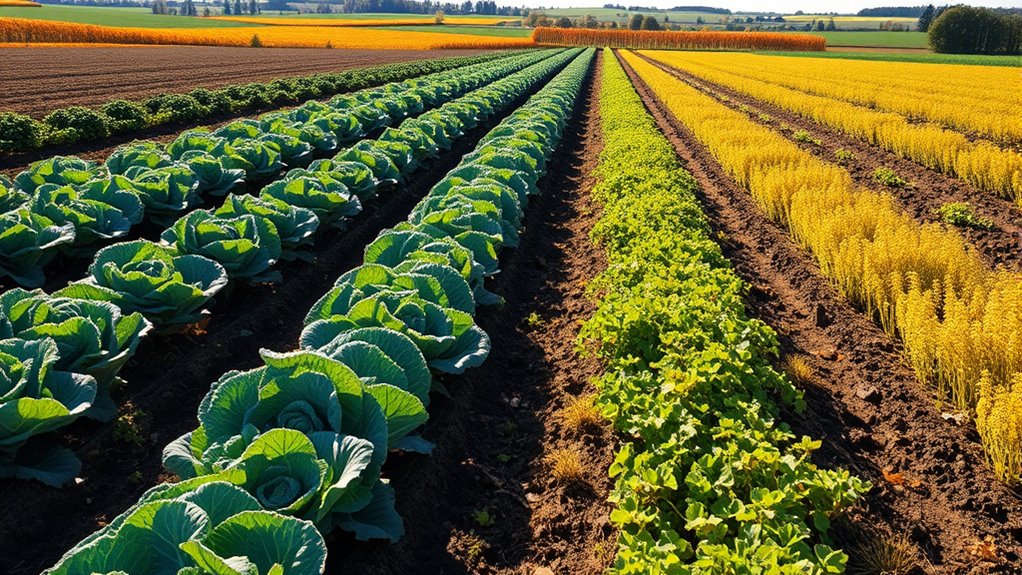
Incorporating cover crops and soil amendments into your fall brassica rotation can substantially improve soil health and productivity. Selecting the right cover crop depends on your goals, such as nitrogen fixation, weed suppression, or erosion control. Use soil amendment strategies like compost or lime to balance pH and add essential nutrients. Cover crop selection should align with your crop’s needs and local climate, ensuring quick establishment and growth. Applying organic matter enhances soil structure and microbial activity, supporting healthy root development. Consider integrating cover crops like clover or vetch for nitrogen, or rye for cover and organic matter. Regularly testing your soil helps fine-tune amendments, maximizing benefits and ensuring your brassicas grow in ideal conditions.
Managing Pests and Diseases in Fall Brassicas

After applying cover crops and soil amendments to improve soil health, it’s important to turn your attention to managing pests and diseases that can threaten your fall brassicas. You can reduce pest pressure by using companion planting, such as planting onions or garlic near your brassicas, which naturally repel pests. Installing pest barriers, like row covers, provides a physical shield against insects. Regularly inspect plants for early signs of disease, and remove any infected leaves immediately. Rotate crops each year to prevent pest buildup. The table below highlights effective strategies:
| Strategy | Benefits |
|---|---|
| Companion planting | Repels pests, enhances plant health |
| Pest barriers | Prevents insect access, reduces damage |
Tips for Harvesting and Extending Your Brassica Growing Season

To maximize your harvest and extend the growing season for brassicas, timing your harvest correctly is essential. Use proper harvesting techniques to guarantee your crops stay fresh and prevent damage. Look for signs like tight heads or fully developed leaves before picking. After harvesting, choose suitable storage methods to prolong freshness—cool, humid storage works best for most brassicas.
Timing and proper harvesting ensure fresh, long-lasting brassicas with minimal damage.
Consider these tips:
- Harvest early in the cool morning to reduce stress on plants.
- Use sharp tools for clean cuts, minimizing plant damage.
- Store vegetables in perforated containers to allow airflow.
- Keep brassicas in a cool, dark place to extend shelf life.
Frequently Asked Questions
How Do Weather Variations Affect Fall Brassica Planting Success?
Weather variations markedly impact fall brassica planting success. You need to take into account climate adaptability and how temperature fluctuations can influence germination and growth. Cooler temperatures promote healthy development, but unexpected warmth or cold snaps can stress plants or delay maturity. By monitoring weather patterns closely, you can adjust planting times and select resilient varieties to guarantee a successful fall crop despite weather unpredictability.
Can Fall Brassicas Be Grown in Containers or Limited Spaces?
You can absolutely grow fall brassicas in containers or small spaces—imagine turning a tiny balcony into a lush, green vegetable haven! Container gardening makes space-efficient planting a breeze, letting you harvest fresh, crunchy brassicas right outside your door. With the right pots and soil, these plants thrive, proving that even limited space can yield bountiful fall crops. No yard needed—just creativity and a little bit of space!
What Are Common Signs of Nutrient Deficiencies in Fall Brassicas?
You’ll notice nutrient deficiencies in fall brassicas through foliar discoloration, such as yellowing or purpling leaves, and stunted growth that doesn’t develop properly. These signs indicate your plants aren’t getting enough essential nutrients like nitrogen, phosphorus, or potassium. Regularly check for changes in leaf color or size, and address deficiencies promptly with appropriate fertilizers to keep your brassicas healthy and thriving during the fall season.
How Can I Improve Soil Fertility Specifically for Brassicas?
To improve soil fertility for brassicas, you should incorporate organic compost into your soil. This soil amendment enriches nutrients and boosts soil health, providing a better environment for root growth. Additionally, consider testing your soil to identify specific deficiencies and adjust with organic amendments accordingly. Regularly applying compost helps maintain nutrient levels, enhances soil structure, and promotes vigorous brassica growth, ensuring a healthy and productive crop.
Are There Organic Methods to Control Pests on Fall Brassicas?
Pest control on fall brassicas can feel like fighting an army of invaders, but organic methods are your best defense. You can use companion planting—think marigolds or nasturtiums—to repel pests naturally. Incorporate biological controls like beneficial insects, such as ladybugs or parasitic wasps, which target pests without chemicals. These eco-friendly strategies protect your crops while maintaining healthy soil and environment, ensuring a bountiful fall harvest.
Conclusion
By planning your fall brassica rotation now, you set the stage for a bountiful harvest—think of it as your garden’s own version of the Great Pyramid, built step by step. Keep timing, soil prep, and pest management in check, and you’ll enjoy crisp, fresh greens well into the cooler months. Remember, even in a world of Wi-Fi and smartphones, good planning remains your most powerful tool for a thriving garden.





